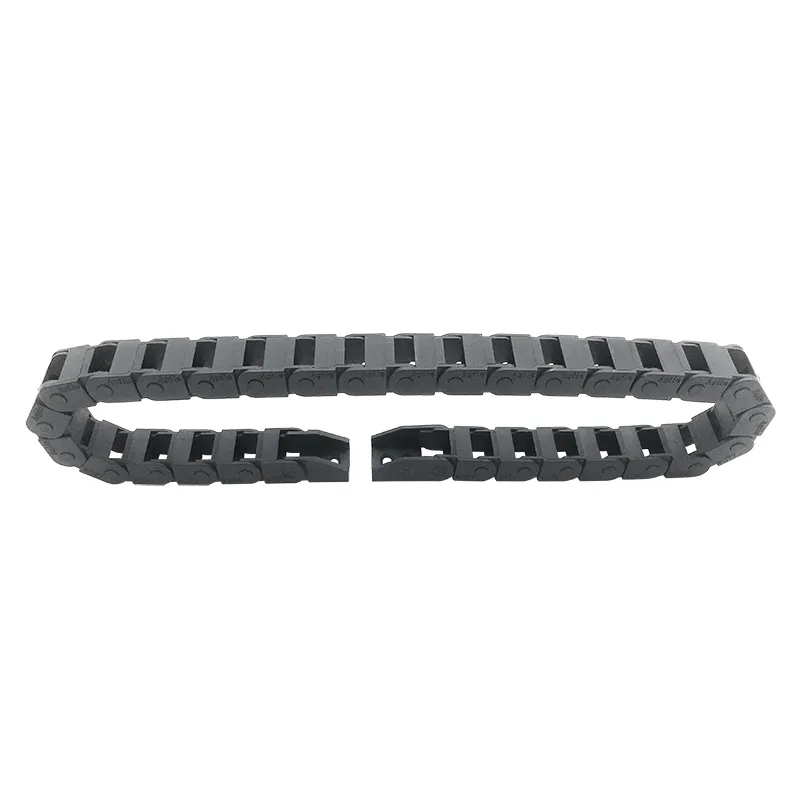semi enclosed cable chain
The Semi-Enclosed Cable Chain Revolutionizing Cable Management
In the world of engineering and manufacturing, efficient cable management is crucial for the streamlined operation of machinery and equipment. Among the various solutions available, the semi-enclosed cable chain has emerged as a revolutionary innovation. This article explores the design, advantages, applications, and future of semi-enclosed cable chains in modern industries.
Understanding Semi-Enclosed Cable Chains
A semi-enclosed cable chain, often referred to as a drag chain or cable carrier, is a mechanical device designed to facilitate the smooth movement of cables and hoses. Unlike traditional open cable chains, which leave cables exposed to environmental hazards, semi-enclosed chains provide a protective channel with partial enclosures. This design helps safeguard the cables from dirt, debris, and physical damage while allowing for flexibility in movement.
Manufactured from materials such as plastic, steel, or aluminum, semi-enclosed cable chains come in various sizes, lengths, and shapes to accommodate different applications. The versatility of their design allows them to manage a variety of cables, including power cables, data cables, and fluid hoses.
Advantages of Semi-Enclosed Cable Chains
1. Protection from Environmental Factors One of the main benefits of using a semi-enclosed cable chain is the superior protection it offers against dust, moisture, and other contaminants. This is especially crucial in industries such as manufacturing, automotive, and aerospace, where the operational environment can be harsh and unforgiving.
2. Enhanced Durability The materials used in the construction of semi-enclosed cable chains are often selected for their strength and resistance to wear and tear. This durability translates into a longer lifespan for both the cable chain and the cables housed within it, reducing the need for frequent replacements and repairs.
3. Improved Aesthetic and Organization By encapsulating cables within a defined structure, semi-enclosed cable chains help maintain a tidy workstation or machine environment. This organization not only enhances the overall aesthetic but also contributes to safety by minimizing tripping hazards and the risk of damage to exposed cables.
4. Flexibility and Mobility Semi-enclosed cable chains are designed for dynamic applications where movement is required. They can accommodate multi-directional motion, such as linear, rotary, and even simultaneous movements in various machines. This flexibility is vital for robotic systems, CNC machines, and other automated equipment.
semi enclosed cable chain

5. Ease of Maintenance The design of semi-enclosed cable chains allows for easier access to cables for inspection and maintenance. This accessibility minimizes downtime and ensures that any necessary repairs can be carried out quickly and efficiently.
Applications in Various Industries
The versatility of semi-enclosed cable chains makes them suitable for a myriad of applications across different sectors. In the manufacturing industry, they are commonly used in conveyor systems and assembly lines to ensure systematic cable management. In the robotics field, these chains allow for the efficient operation of robotic arms and automated guided vehicles.
In the automotive industry, semi-enclosed cable chains play a crucial role in assembling vehicles, where various cables and hoses must remain protected and organized. Similarly, in the aerospace sector, where precision is paramount, these cable chains help protect vital wiring systems during aircraft assembly and maintenance.
The Future of Semi-Enclosed Cable Chains
As industries continue to evolve, the demand for more innovative and effective cable management solutions will undoubtedly rise. The future of semi-enclosed cable chains looks promising, with advancements in materials technology and design engineering paving the way for even better performance.
Emerging trends, such as smart manufacturing and IoT (Internet of Things), are anticipated to influence the development of cable chains. Designs that incorporate sensors and wear indicators could enhance monitoring and maintenance, reducing downtime and improving operational efficiency.
Furthermore, the increasing emphasis on sustainability means that manufacturers are likely to explore eco-friendly materials and production processes for semi-enclosed cable chains, aligning with global efforts towards reducing environmental impacts.
Conclusion
In a landscape where efficiency, safety, and durability are paramount, semi-enclosed cable chains are proving to be an invaluable asset across multiple industries. Their protective design, coupled with ease of maintenance and versatility, positions them as a key player in the advancement of cable management solutions. As technology and industry practices continue to evolve, semi-enclosed cable chains will undoubtedly adapt and thrive, ushering in a new era of cable management efficiency.








